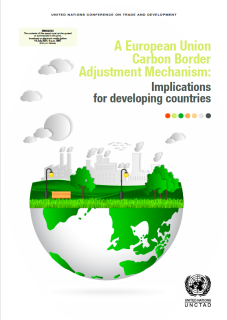
As part of a plan to decarbonize its economy by 2050, the European Union is considering the introduction of a carbon border adjustment mechanism (CBAM) to reduce the risk of carbon leakage and to level the field for European industries working towards decarbonization of their production processes. Using a general equilibrium model, this study looks at the potential effects of a CBAM on international trade, carbon dioxide emissions, income and employment, with a special focus on developing and vulnerable countries.
The study confirms that the introduction of carbon pricing coupled with a CBAM helps reduce carbon emissions, inside and outside the EU. International trade patterns change in favour of countries where production is relatively carbon efficient, generally resulting in declining exports in developing countries.
To simultaneously promote green economy and inclusive trade, the report discusses the potential benefits of implementing CBAM flanking policies. This includes using revenue generated by the CBAM to accelerate the diffusion and uptake of cleaner production technologies among developing country producers.
